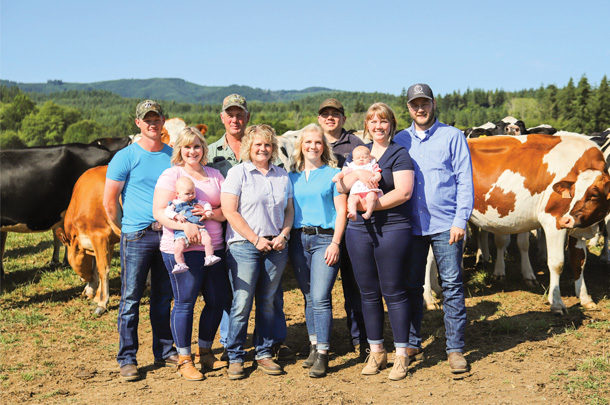You know how farm life goes. The work never seems to cease, and the thought of finding a spare moment for much of anything else can seem like a distant hope. We certainly feel it on our dairy here in Raymond, Washington, an area that gets its share of rainfall located about an hour from the Pacific Ocean. We’re in the middle of logging country, and there are big, beautiful trees all around us, a scene we sometimes take for granted. My husband, Terry, and I are the fourth generation at this farm, which my great-grandfather, a Swiss immigrant, purchased on the courthouse steps in 1932.
We milk 270 Holsteins – and while we have four employees, a great deal of the work falls to us and our four children, who spent a good deal of their infancy in cribs in the milkhouse.
So while our days are filled, there are some things we need to make time for that are crucial to our industry’s future. We’re becoming a smaller bunch in our country, with our dairy farm numbers around 31,000. As a result, the general population knows less about us and the great work we do every day to care for our land and our animals.
But it isn’t just the average consumer who’s interested in how we farm. It’s also our customers, including some of the country’s – and world’s – largest retailers, quick-serve restaurant chains and processors. Leadership within these companies may not be familiar with the people behind the dairy products they sell.
That’s why I gladly participated in a recent virtual farm tour webinar with more than 40 representatives from some very recognizable companies dialed in. Our audience included decision-makers from Whole Foods, H-E-B, Yum! Brands (Pizza Hut and Taco Bell), Wendy’s, Sodexo, Sysco, Costco, Publix, McDonald’s, Darden Group and Ahold Delhaize.
United front
The event – tabbed as “Dairy 101” – was hosted by the checkoff-founded Innovation Center for U.S. Dairy and its Food Chain Outreach team in conjunction with the National Milk Producers Federation. The webinar covered insights on how milk travels from the farm to the fridge, including dairy regulatory programs and animal care assurance programs.
It was an honor to join my peers from across the country: Tyler Ribeiro (California), Ty Hildebrandt (Wisconsin) and Sutton Rucks (Florida). Also joining us was Dr. Karen Jordan, a North Carolina dairy farmer who doubles as a veterinarian.
None of us knew each other before our presentation, but it’s always easy to feel a bond with one another and connect over the many things that unite us, no matter where we farm. While we represented views and styles from very different geographies, we showed our audience how united we are around these crucial foundations of our businesses.
We shared overriding messages related to the care for our animals and our land. For example, Sutton spoke about land conservation, calf management and how dairy farmers manage cows in different weather conditions. Then, Ty highlighted how they harvest milk and transport it to a manufacturing plant. Next, the audience learned about methane digesters, byproduct utilization and nutrient upcycling from Tyler in California, followed by my farm.
I was joined by our nutritionist, who stressed the importance of feeding a well-balanced and highly nutritious diet to our cows. I also am a registered dietitian and enjoyed solidifying the message of how – like humans – our cows need to eat well to be at their best.
Changing times
The three generations who preceded us on our farm did not have the need for outreach such as we do today. My grandparents didn’t have to worry about explaining to consumers where their milk comes from, as people in their generation were much more connected to agriculture.
It’s a much different story now, and farmers must put themselves out there to help provide an accurate understanding of the work we do. This isn’t just important for the average consumer but for those who manage our product once it leaves the farm. I’m grateful the dairy checkoff and NMPF recognized the need for us to connect with leaders such as those on our virtual webinar.
It was an honor to show representatives from these major companies that we’re human; we work hard, and we strive every day to do our best. Our cows are family, and we invest in them. And the people who work for us also are family. Every day, we all come together to feed America and the world, and we’re very good at what we do.
While our days are filled with one more thing to do, advocacy is something that will maintain its place among our farm’s priorities.
To learn more about your national dairy checkoff, visit U.S. Dairy or send a request to join our Dairy Checkoff Farmer Group on Facebook. To reach us directly, send an email to Talk To The Checkoff.
The following update is provided by Dairy Management Inc. (DMI), which manages the national dairy checkoff program on behalf of America’s dairy farmers and dairy importers. DMI is the domestic and international planning and management organization responsible for increasing sales of and demand for dairy products and ingredients.




